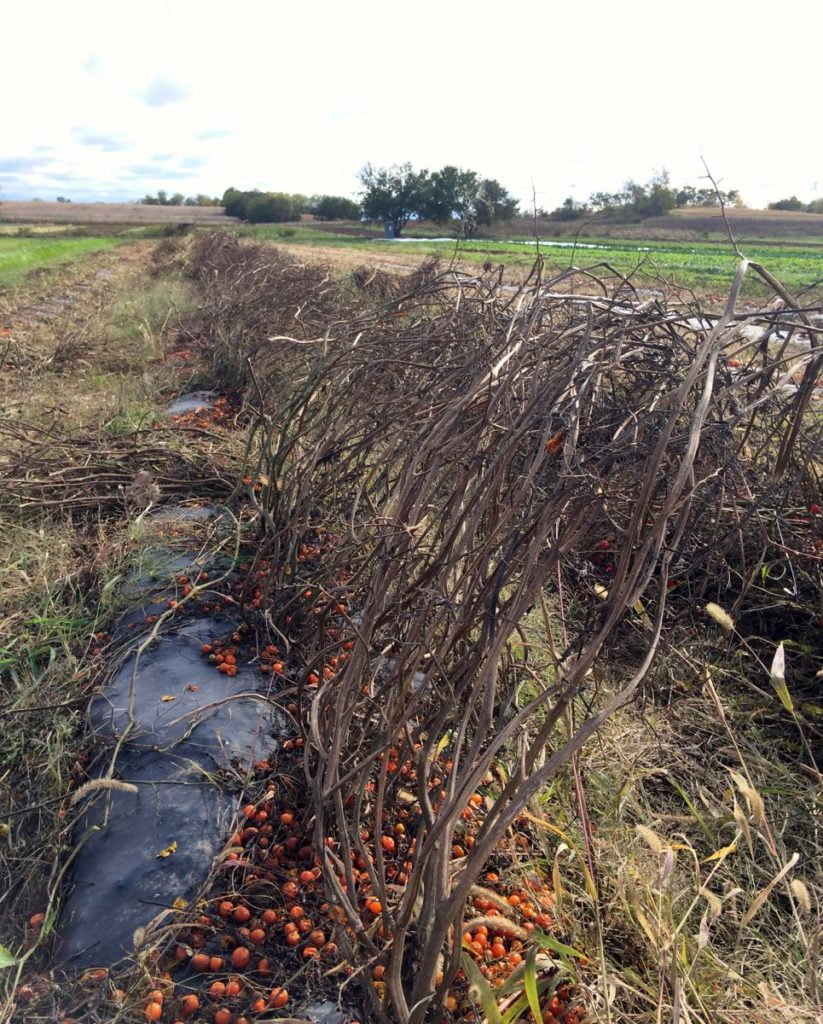Monthly Archives: October 2019
Week #24; Final delivery of the regular season!
- On: October 30, 2019
 0
0
Thank you!
Folks, this is the final delivery of our regular CSA season. Thank you for joining our farming adventure this year! We could not farm without the support of you, our community of eaters. We hope you enjoyed the produce, the newsletters and recipes, and the farm events.
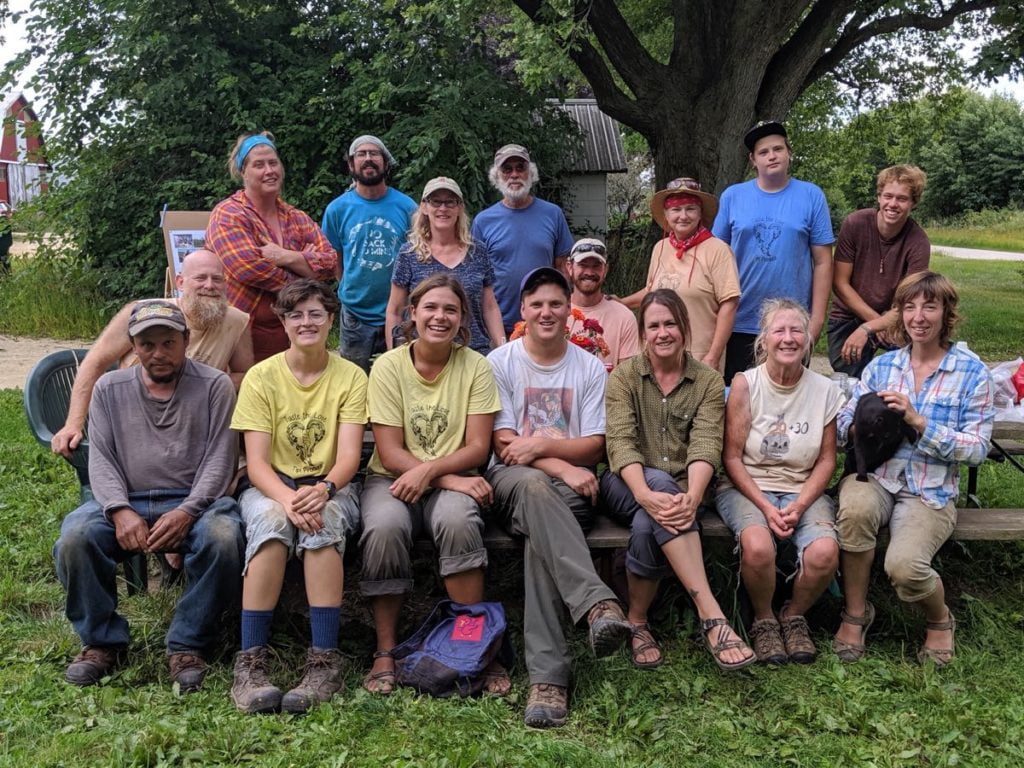
All your farmers thank you. From left, back row; Ben (seated), Maggie, Smitty, Beth, Steve, Billy (seated), Linda, Chance and Michio. Front row; Raul, Monika, Anna, Jory, Karen, Simone, Kerry. MIA Alex, David, Jim, John, Josh, Kristin and the high school crew.
What a week
I often reflect on the season for this final newsletter. Not this year. The cold snap and coming snow forced us to hustle to bring in frost-sensitive crops, and to get garlic planted for next year. It’s been quite a week. After the snow melts, it will take another week or two to finish harvesting our root crops. We don’t like leaving them in the field in such cold weather but the roots are snug in the still-warm soil and the tops will (hopefully) remain strong enough to pull with our harvesting equipment. A blanket of snow will insulate the carrots but make a muddy harvest next week.
Soon, we will be done for the season. This year has taken a lot of effort, and we look forward to our winter rest. By January, we’ll have our plans finalized and will start ordering seeds. By late February, the greenhouse will be running and seeds sprouting. We hope most of you will join us again next season. We’ll be in touch this winter.
Beth and Steve
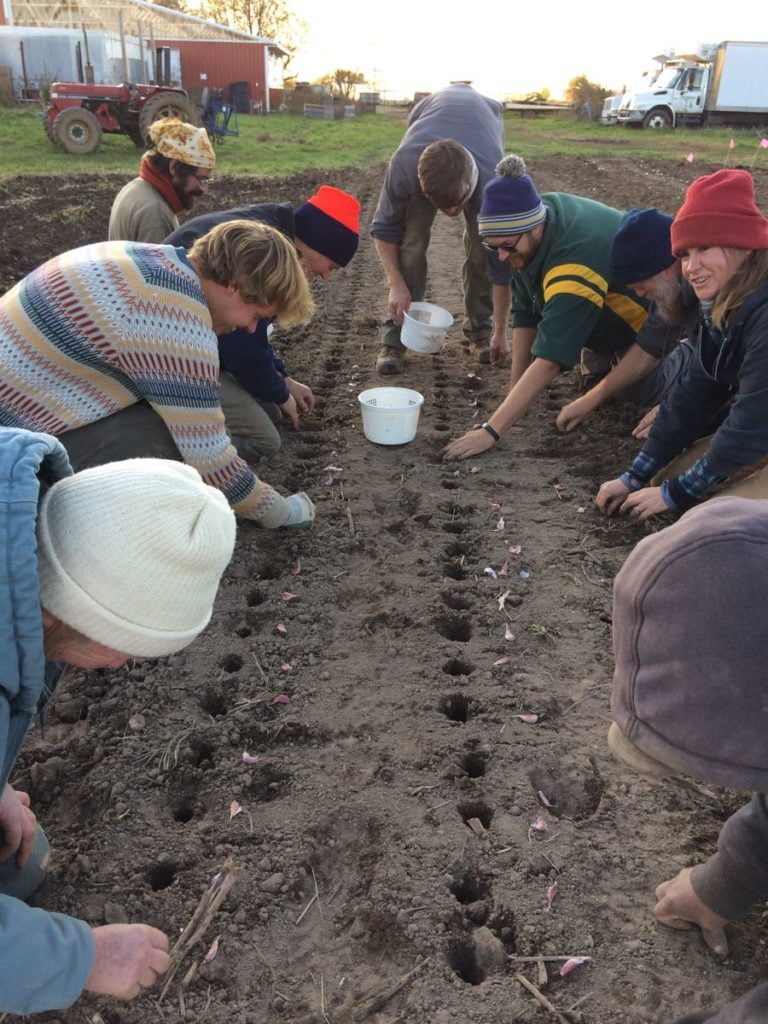
We planted garlic on Friday, before the weather turned wintery. You really need dry soil for this job. We rarely work in such a tight cluster but were at the end of the row and everyone was having fun together.
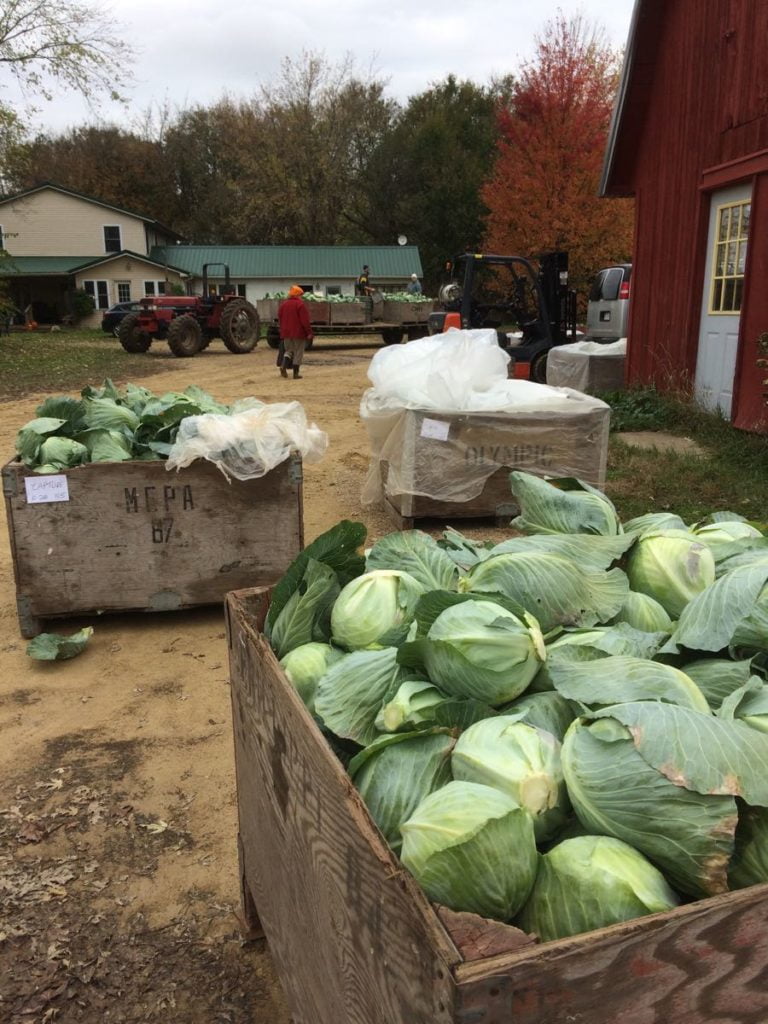
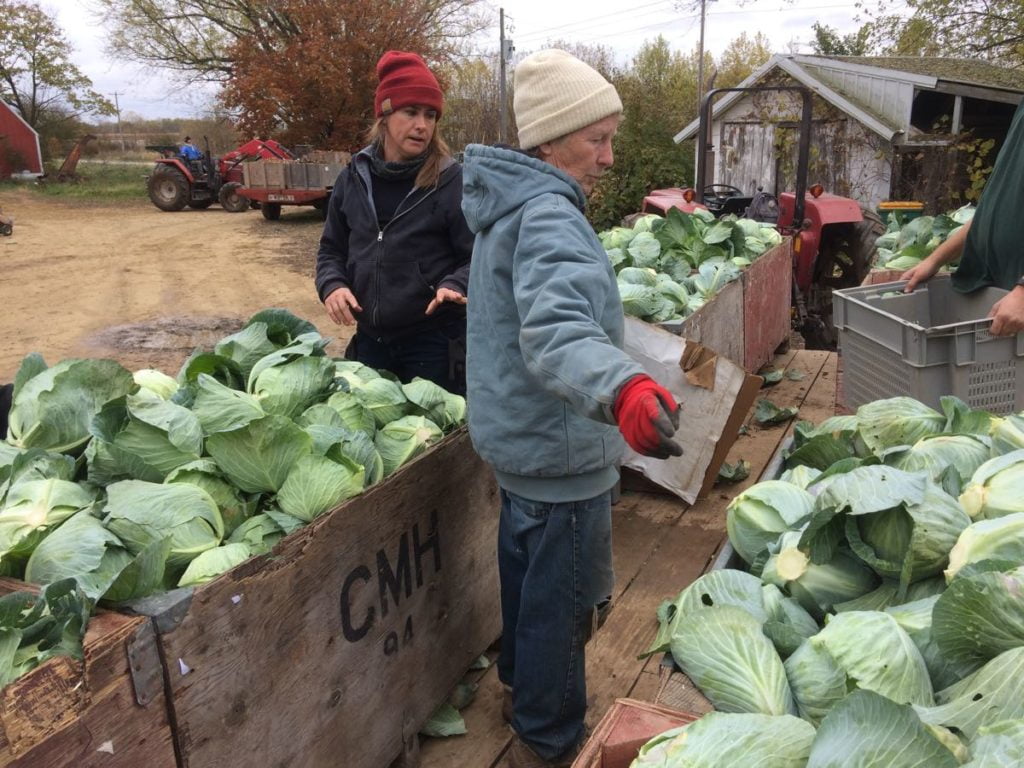
Cabbage is a very important crop for us, something we’ll store and sell through the winter. However, it won’t survive the low temperatures predicted for tomorrow night so we raced to get it all out of the fields. It’s taken a full week. Simone (blue coat) manages our cabbage crop. Above, she and Karen (red hat) make sure that all the varieties are kept separate.
We were simultaneously harvesting carrots with a separate crew. You can see Billy unloading bins of carrots in the background.
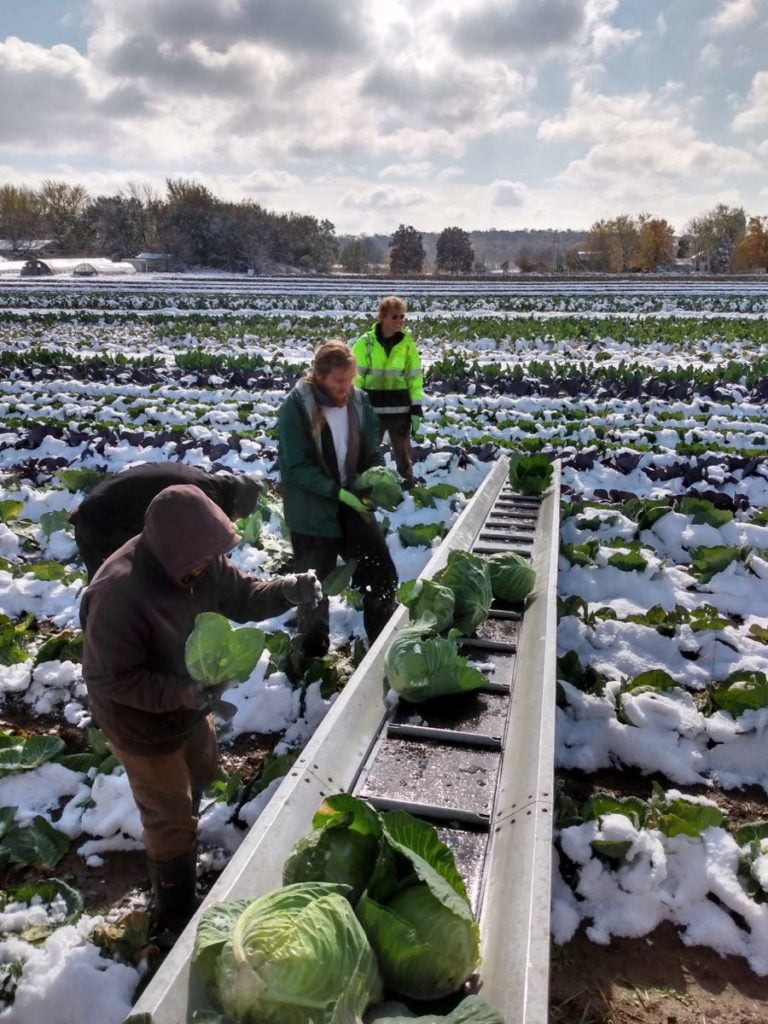
We couldn’t wait for the snow to melt to continue the cabbage harvest. Photo credit, Karen Nicholson
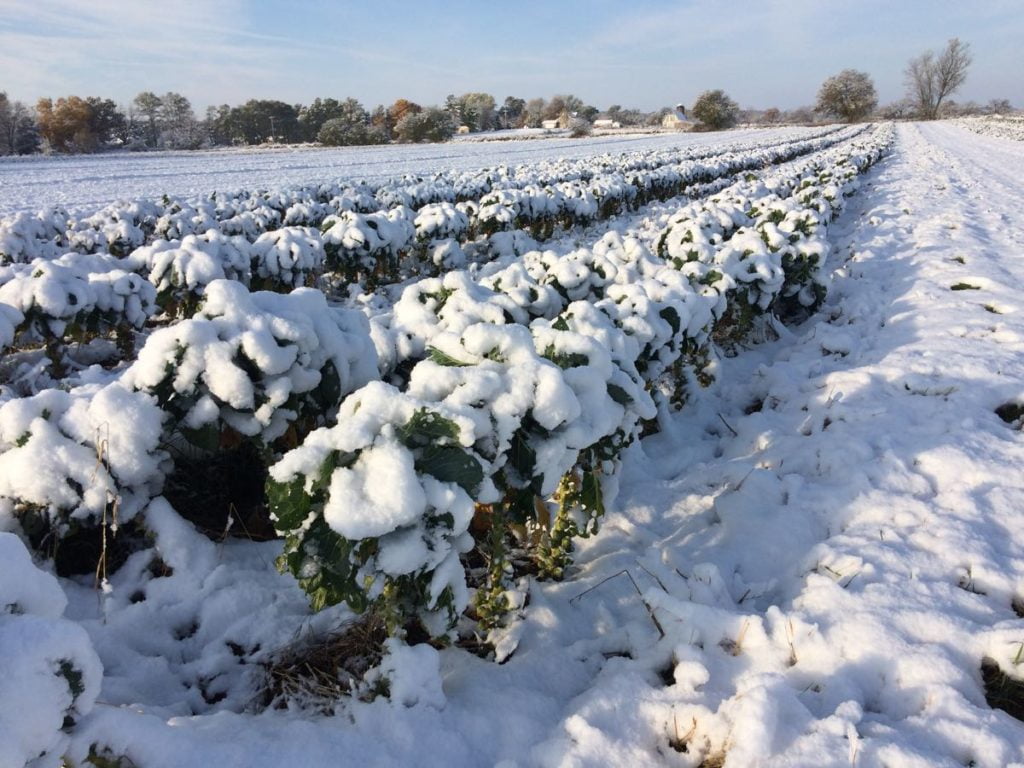
Here are your Brussels sprouts on Tuesday morning. We waited for the snow to (mostly) melt before picking. It’s too much of a mess otherwise, not to mention ridiculously cold. Brussels sprouts are cold-hardy, so we’re not worried about unharvested sprouts left in the field.
Veggie List and Veggie Notes
Week #24 = Final delivery of regular season
October 31/ Nov. 1, 2019 (Thurs/Fri. sites)
– Weekly shares
– EOW/ green
Sweet potatoes, 3 to 3.5 lb
Brussels sprouts, 1 lb
Celeriac, 1 large
Beets, ~2 lb
Carrots, ~2 lb
Koji greens
Bell or frying pepper, 1 or 2
Poblano chiles, 2
Yellow onion
Some sites get broccoli.
Some sites get Romanesco cauliflower.
Sweet potatoes – These are the ‘Beauregard’ variety. Store at room temperature, e.g. on your kitchen counter. Do not cover or wrap in plastic. These will store for a long time.
Brussels sprouts – See last week’s newsletter for cooking information.
Celeriac (knobby, round, bizarre-looking vegetable which smells like celery) – Flavorful celeriac is good raw or cooked. It is excellent in mixed roasted veggies or in soup. It’s especially good in cream soups, alone or mixed with potatoes. Grated raw celeriac is a great starting point for winter salads. Celeriac will store in your refrigerator for months. Cut off chunks as you need them. Peel before using.
Beets – Storage: Cover and refrigerate. Beet roots will store for months. Wash well to remove leaf fragments. For all the cooking methods below, wash and scrub the beets but do not peel. The skins slip off easily once the beets are cooked and cooled.
Cooking beet roots on the stovetop: Slice or quarter, cover with water in a pot, and simmer until tender. This will take from 25 to 45 minutes depending on how large the beet pieces are. Drain.
Roasting beets in oven: Wash beets, but do not peel. On a sheet of aluminum foil, put beets (halved or quartered if large), salt, pepper and a few sprinklings of water. Seal the foil packet, and roast at 400 oF until tender, about 45 minutes to 1 hour. Slip off skins once cool.
Microwave: Slice beets in half and place in a large microwave-proof bowl. Add ¾ inch water and cover with a plate. Microwave on high until tender, about 9-20 minutes, depending on your microwave’s power. Drain and slip off skins.
Uses: Use cooked beets in cold salads, or dress simply with vinaigrette, onions, salt and pepper. Beets are also good tossed with sour cream, minced onion, fresh herbs and walnuts.
Koji greens (head of dark green leaves) – These have some silvering on the tops of the leaves, from rubbing against row cover we used to protect the plants from frost. Just ignore or cut away. Sorry about that.
Koji greens are a lot like Yukina if you know that one; dark green with a nice balance of bitter flavor but not too strong. Like tat soi but with larger, lusher leaves and not so many leaf stalks. Recipes that use mustard greens or bok choy will work with Koji.
Bell or frying pepper – EAT SOON. We protected these plants with row cover outside for as long as we could. They’ve been exposed to cold nights which shortens their storage life. Eat within a few days OR chop and freeze for later. Just toss the frozen pieces into dishes at the end of cooking. We treasure these last few peppers and hope you do too.
Poblano chiles (dark green, shiny, triangular) – EAT SOON, for same reason as the bell peppers. Eat this weekend OR chop and freeze for later. These chiles have low-to-medium heat and great flavor. Most I’ve cooked so far this year were fairly mild, but a few were corkers.
RECIPES
Visit our 2019 Recipe Log or our 2018 Recipe Log or join our Facebook discussion group.
LOCAL THYME/ Comforting Classics
Soy Braised Shrimp with Koji
Nana Maniscalco’s Turkey Barley Soup
Shredded Carrot and Beet Salad with Carrot Ginger Dressing
LOCAL THYME/ Outside the Box Recipes
Vietnamese Noodle Salad with Grilled Beef, Koji and Carrots
Baked Celeriac
Beet Hummus
LOCAL THYME/ Quick & Easy Meal
Black Bean Quinoa Salad with Oranges, Peppers and Roasted Poblanos
????????????
RECIPES FROM LAUREN
BEET & CARROT SLAW WITH KOJI GREENS
Inspired by Bon Appetit
Takes 45 minutes
Serves 4-6
4 garlic cloves, minced
1/2 cup dried currants (or cranberries)
1/4 cup champagne vinegar
2 large (or 1 extra-large) beets, peeled
3-4 large carrots, peeled
2 apples
1 bunch koji greens (reserve the stems for another use), very thinly sliced
1/2 lemon, juiced
1 teaspoon Kosher salt
1/2 teaspoon freshly ground black pepper
1/4 teaspoon red pepper flakes
1/2 cup olive oil
1 cup chopped and toasted almonds
- In a small bowl, combine garlic, currants and vinegar. Let currants plump and garlic mellow in there for at least 20 minutes. It will likely take that long to get your veggies cut up anyhow.
- Cut the beets, carrots and apples into matchsticks and place in a large bowl with the koji greens. Squeeze with lemon and season with salt, pepper, and red pepper flakes. Toss to combine then add the garlic and currant mixture. Drizzle with olive oil and toss several more times to combine. Taste and adjust seasonings as desired.
- Serve with toasted almonds.
.
????????????
.
SWEET POTATO & CELERIAC HASH
Inspired by Bon Appetit
The original recipe that inspired this one didn’t actually call for Brussels Sprouts or poblanos so if you’d rather use them some other way, feel free to leave them out.
Takes 1 hour
Serves 2-4
5 pieces bacon
1 large celeriac, peeled and cut into 3/4-inch dice
1-2 pounds sweet potato, peeled and cut into 3/4-inch dice
1/2 pound Brussels sprouts, halved (quartered if very large)
1/2 teaspoon dried thyme
1 cup chicken broth
1 yellow onion. thinly sliced
2 poblanos, diced
1/2 teaspoon Kosher salt
1/4 teaspoon freshly ground black pepper
2 eggs, optional
Hot sauce, optional
- Preheat oven to 425 degrees.
- Place bacon on a baking sheet and put in oven right away (the oven won’t be preheated yet). Set the oven for 15 minutes and check the bacon then. Add more time if its not done. Once finished, drain grease on paper towel but do not wash pan or get rid of the grease left on the pan– you will use in the next span.
- In a large heavy skillet, combine celeriac, sweet potatoes, and Brussels sprouts. Add thyme and broth. Bring to a boil over medium high heat and cook for 20 minutes stirring occasionally until the vegetables are soft.
- Add softened vegetables to baking sheet you cooked the bacon on. Add onion and poblanos. Sprinkle with salt and pepper. Roast for 40 minutes, stirring after 20 to make sure veggies on the bottom do not burn.
- Serve hash with eggs and hot sauce.
- Cut bacon into pieces and sprinkle over the finished dish. Add more salt or pepper to taste.
.
Week #23, final purple & sun!
- On: October 23, 2019
 0
0
Schedule count down
– This week (October 24/25) is the final delivery for our EOW/purple and Sampler/sun members.
– Next week (Oct. 31/ Nov. 1) will be the final delivery for our Weekly and EOW/green members.
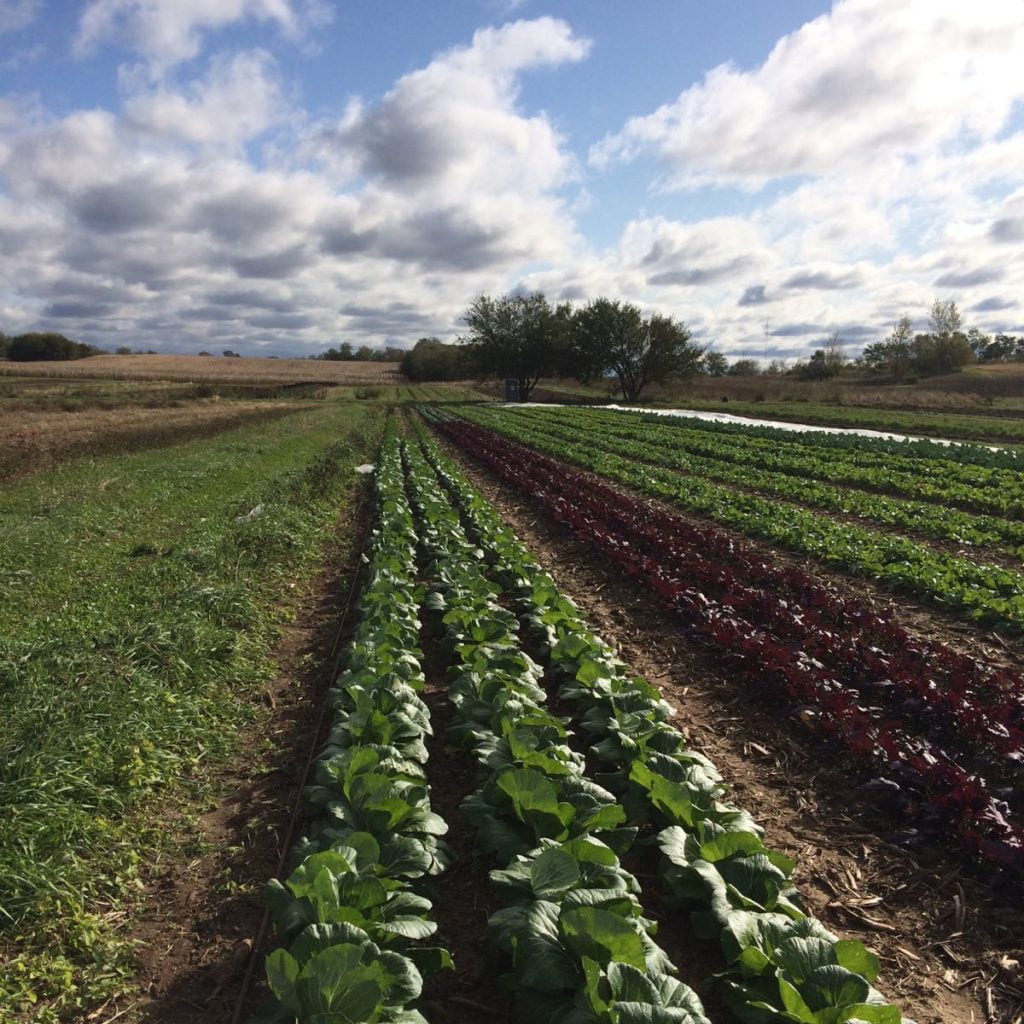
Your bok choy came from this pretty field of greens.
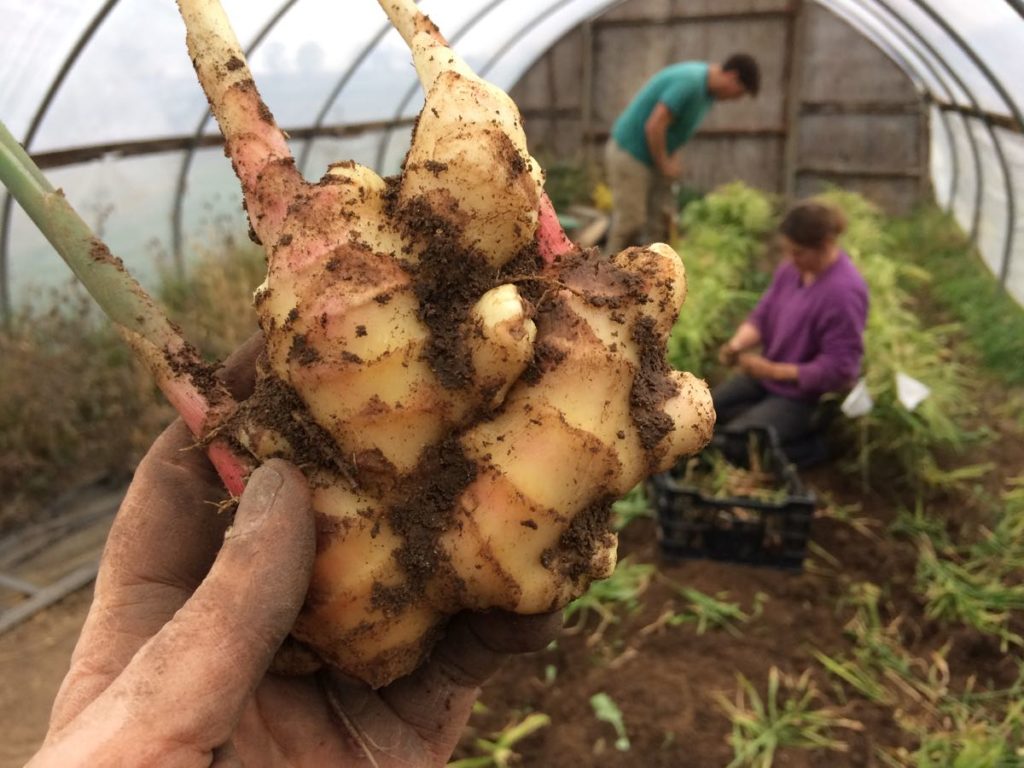
We dug our baby ginger this week. It’s a nice crop this year, enough to deliver a plump piece in every CSA box. In background, Jory and Karen dig the ginger. My job is to divide the harvested rhizomes into portions. It’s a bit of a jigsaw puzzle. I’ll probably divide the root in the photo into three portions. I almost gave up growing ginger because the yields are so low. It simply needs a longer season than we have in Wisconsin. This spring, I tinkered with our planting techniques to get an early start on the season. It worked, so the ginger pieces are bigger this year. We have not yet replicated our spectacular 2015 crop, but we’ll keep trying.
Veggie List and Veggie Notes
Week #23, October 24/25, 2019
– Weekly shares
– EOW/ purple
– Sampler/ sun
We’re packing bok choy with scallions and ginger because they are a great combo for stir-fries or Asian dishes. I plan to make chicken soup, then add bok choy and ginger near the end of the cooking time, then garnish with sliced scallions.
Bok choy
Brussels sprouts, 1 lb
Butternut squash
Yellow potatoes, 3 1/4 lb
Leeks, 1.3 lb
Parsnips, ~1.5 lb
Peppers, a few green bells or fryers
Jalapeno chile, 1
Scallions, 1 bunch
Baby ginger, 1 piece
Each site gets something from this list: broccoli OR cauliflower (white or purple) OR Romanesco broccoli OR maybe something else.
Next week’s box will probably contain Brussels sprouts, beets, carrots, celeriac, onions, Asian greens, sweet potatoes OR winter squash, and more.
Bok choy (large rosette with thick white stems and green leaves) – The bok choy has some minor damage from being covered with row cover on frosty nights. It’s a reasonable trade-off, since we can’t leave it unprotected and risk damage by frost.
This Asian green is good for stir-frying or sautéing or in soup. You can think of the stems and leaves as two separate vegetables. The stems require longer cooking. The leaves will cook almost as quickly as spinach. Storage: Bok choy stores well, so feel free to pull off leaves as you need them, or use the whole head at once. Refrigerate in a plastic bag or other container.
Brussels sprouts – If you are a new CSA member, please approach Brussels sprouts with an open mind. Many of us grew up eating awful, overcooked Brussels sprouts. These Brussels sprouts are completely different.
Here is our method to cook Brussels sprouts: Wash the sprouts and trim the cut ends. Cut an X in the stem end of large sprouts. Cut a single slit in small or medium sprouts. This does two things. It helps the Brussels sprouts cook evenly, plus it allows them to soak up any marinade or dressing. Place sprouts in a pot with one inch of water in the bottom and steam until tender, 7 to 10 minutes. If the sprouts are uneven in size, then set aside the smallest ones and add to the pot after the larger ones have cooked for a few minutes. Don’t overcook them! You can also oven-roast Brussels sprouts.
Here are a few dressing ideas for cooked sprouts:
– Sherry vinegar/olive oil/Dijon mustard/garlic/white wine/salt and pepper. This is our favorite, especially when you combine the Brussels sprouts with slivered peppers and thinly sliced onions. Delicious warm, cold, or at room temperature.
– Balsamic vinegar/olive oil/garlic/salt and pepper
– Lemon juice and zest/melted brown butter/poppy seeds/white wine/garlic/salt
Satina yellow potatoes – These organic potatoes were grown by our friends at Igl Farms. Satina is a good all-purpose potato. Personally, I like these better than Yukon Golds because they’re a little less sweet.
Peppers – Eat these soon! They’ve been exposed to cold nights, which shortens their storage. You’ll get green or green/red peppers. Could be bells, could be frying peppers, could be a mix.
Baby ginger – This is baby ginger, bright white and pink because it hasn’t grown a brown epidermis yet. The ginger sold in stores grows for a long season in warm places like Hawaii. Baby ginger is special because it has the full ginger flavor and spiciness but almost no fibers. That’s why it’s used to make the pickled ginger served with sushi. I asked the crew to wash it lightly to avoid bruising. Expect to do a final wash before using it.
Storage: Eat soon; baby ginger is perishable. Wrap in a damp cloth or paper towel, and keep in the refrigerator in a plastic bag. You can also freeze your ginger, then grate as much as you need from the frozen knob.
RECIPES
Visit our 2019 Recipe Log or our 2018 Recipe Log or join our Facebook discussion group.
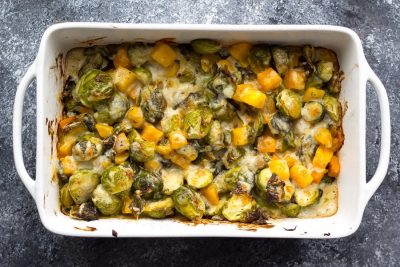
Brussels sprouts gratin
LOCAL THYME/ Comforting Classics
Butternut, Brussels Sprout and Leek Gratin
Creamy Brussels Sprouts and Potato Soup
Red Curry with Chicken, Peppers, Parsnips and Potato
Tofu, Bok Choy and Pepper Fried Rice

Congee with Bok Choy
LOCAL THYME/ Outside the Box Recipes
Butternut Cookies
Sautéed Sesame-Ginger Brussels Sprouts
Pear Parsnip Puree
Bok Choy Congee
LOCAL THYME/ Quick & Easy Meal
Salisbury Steak with Leek, Pepper, and Mushroom Gravy
????
Week #22; Dismantling summer
- On: October 16, 2019
 0
0
In the home stretch.
It’s hard to believe but we only have three more regular-season CSA deliveries, including this week. Let’s review our schedule.
October 17/18 (this week) = EOW/green
October 24/25 = final EOW/purple week and final Sampler/sun week
October 31/Nov. 1 = final delivery for Weekly shares and EOW/green.
Extension & Storage share members, I sent you a confirmation email on October 2 for each share. That email has your Extension or Storage delivery date.
Dismantling summer
Frosty nights this past weekend finished off our tomatoes (a merciful end) and two of three pepper fields. We built those fields just a few months ago, pounding posts for tomato trellises, pulling weeds around each pepper plant. When the tomato posts are pulled, the skeletons of exhausted, frosted plants still stand, ready for mowing. On the other hand, peppers remain vigorous and loaded with small young fruits that will not mature on cold-damaged plants. Such promise! But not in Wisconsin.
We hustled to bring in tender crops before the frost. Sweet potatoes were a priority because they are so sensitive to cold temperatures. We dug our final two beds last week and tucked them into a heated, insulated box. We cure them at 85 F for a week to convert starches to sugar. Tomorrow, we’ll drop the temperature and gives them lots of air circulation to set the skins.
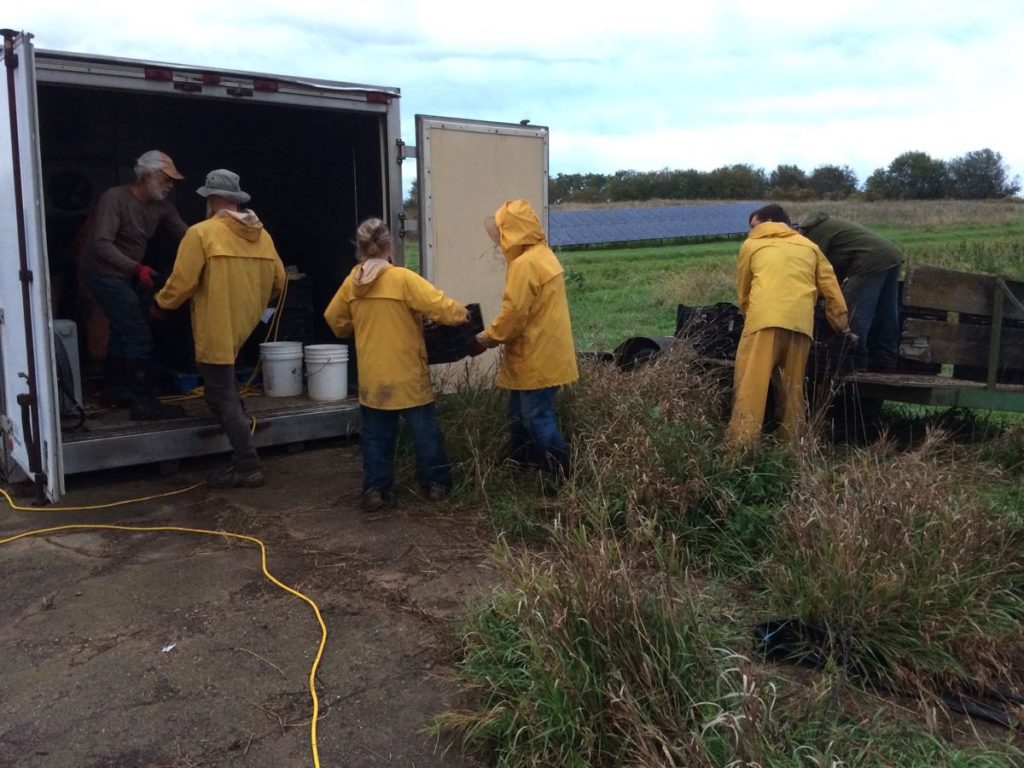
The crew loads freshly dug sweet potatoes into an insulated truck box.
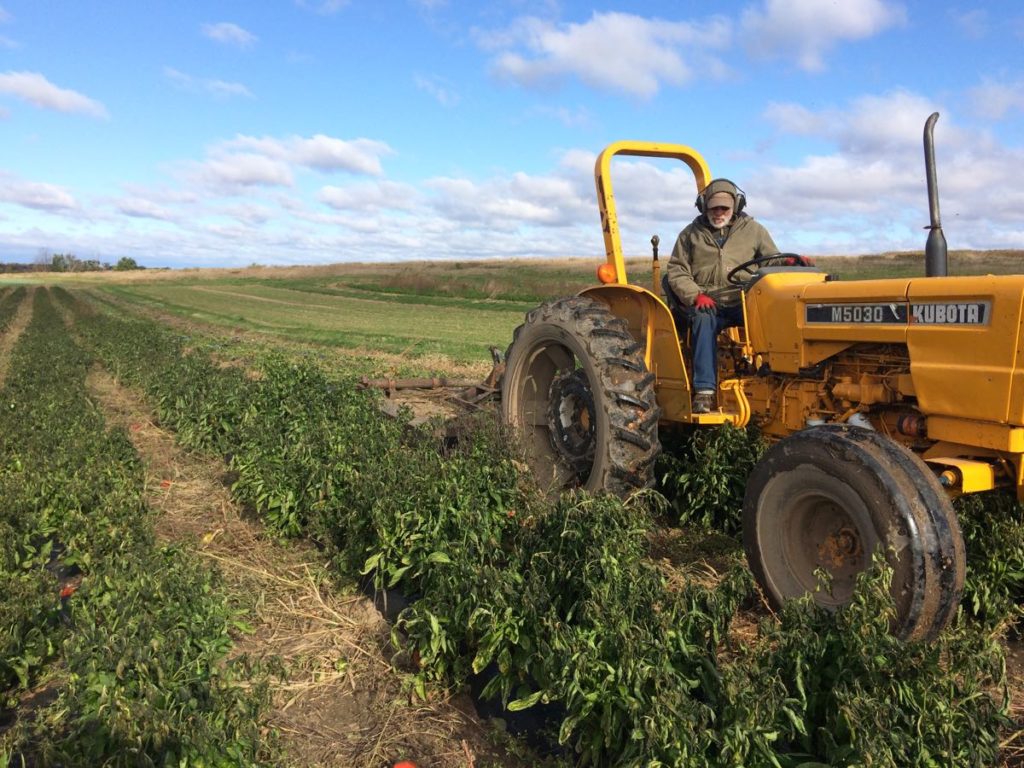
We hurried to strip pepper fields before the frost. You’ll get a mix of green bell peppers and ones that are half green and half red. We are out of time for those to turn fully red so let’s enjoy them now. In the photo above, you can see that the tops of the plants are brown and wilted after frost on Sunday night. Steve chopped the pepper plants down so we can get the field seeded to a cover crop.
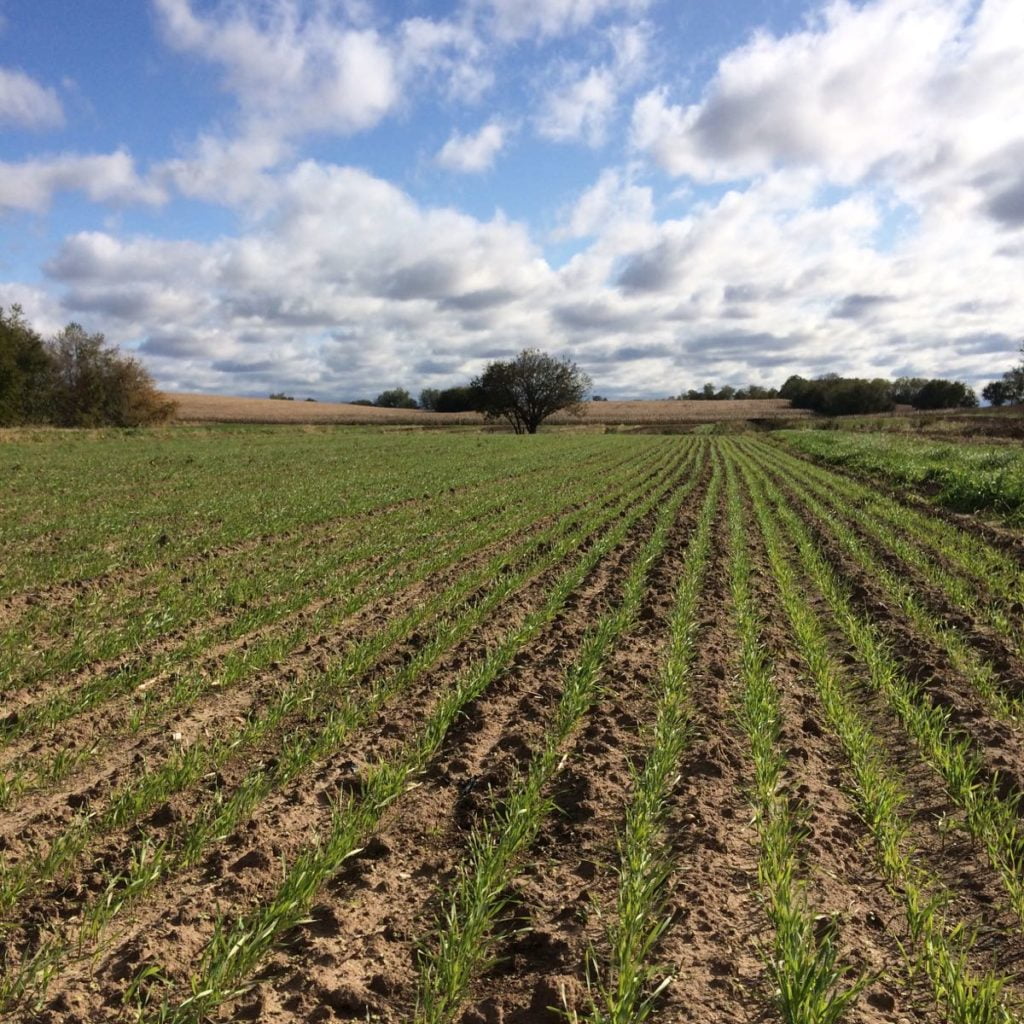
This field has a nice stand of rye and hairy vetch cover crop. The plants will keep growing until the ground freezes then will re-start growth in early spring. The cover crop keeps the soil covered and anchored over winter, then enriches the soil in spring when we till in the fresh organic matter.
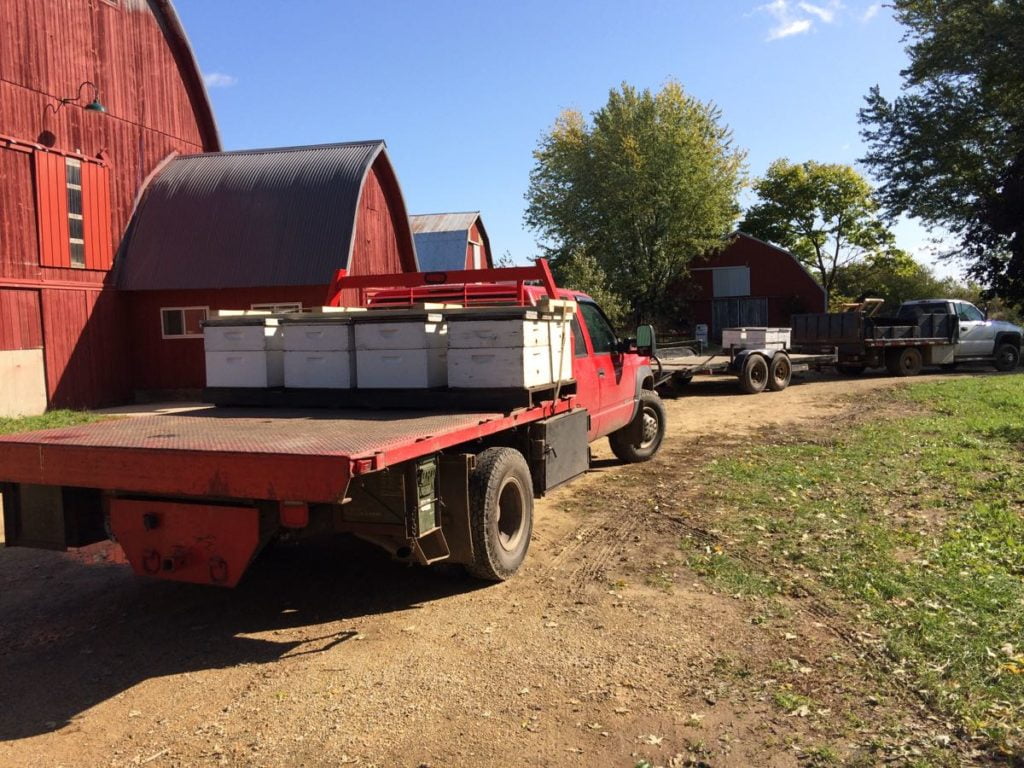
Even the bees are packed up and returned home to our beekeeper’s farm!
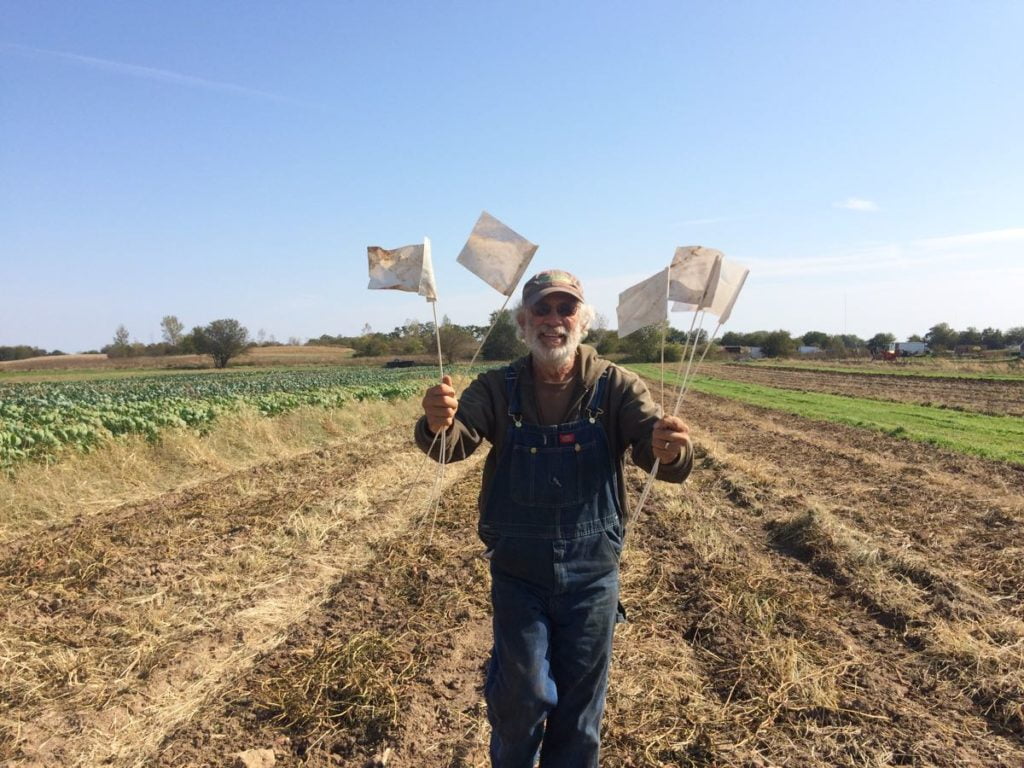
Steve surrenders! Actually, he’s just pulling marker flags before tilling the finished sweet potato field.
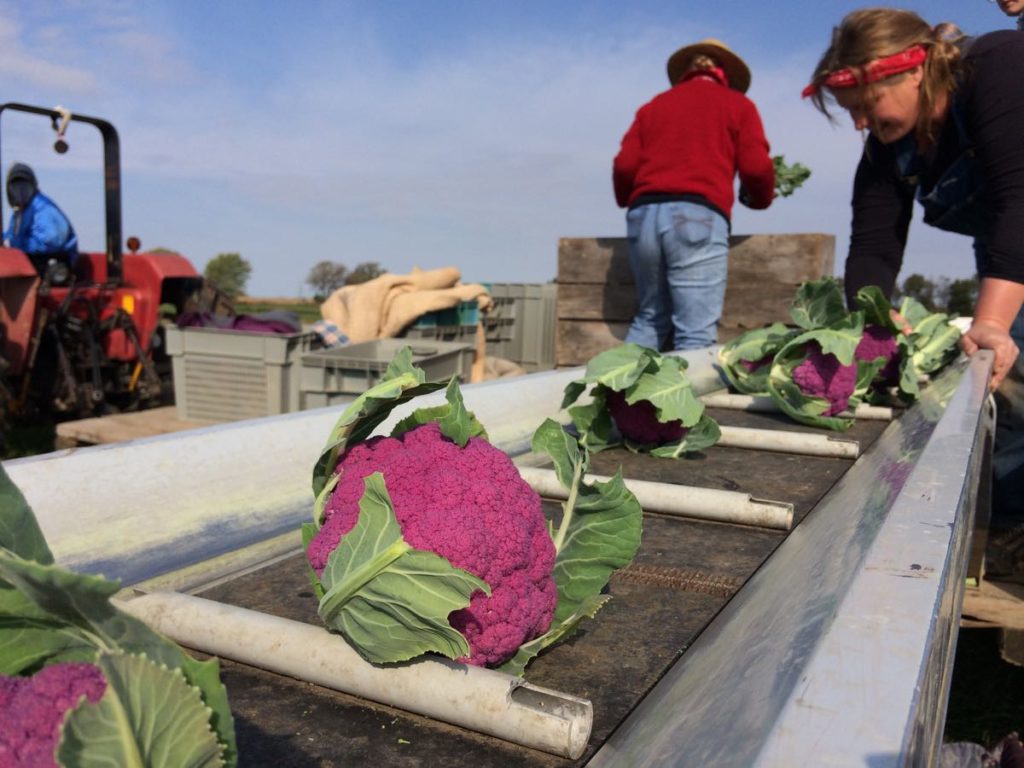
Of course, we’re still harvesting fall crops.
Enjoy the Indian summer this week. We sure will!
Beth & Steve
Veggie List and Veggie Notes
Week #22, October 17/18, 2019
– Weekly shares
– EOW/ green
Green cabbage
‘Nutterbutter’ butternut squash
Bell peppers, ~3, green or red/green
Purple or white cauliflower
Some sites get a 2nd cauliflower, some get broccoli.
Carrots, 2 lb
Parsnips, 1.5 lb
Yellow onion
‘Roulette’ not-hot habanero chiles, 3 or 4
Garlic
Next week’s box will probably contain bok choy, peppers, butternut squash, Brussels sprouts, parsnips, ginger and more.
Green cabbage – This cabbage will last for a long time in your refrigerator. Cut off chunks as needed.
‘Nutterbutter’ winter squash – We’re growing more and more of this early-season butternut variety. It cures quickly and is ready to eat within three to four weeks after harvest, letting us deliver winter squash over a few months.
Bell pepper – Most of your peppers will be “suntan.” That’s farm lingo for half red and half green. We stripped the peppers before frost, knowing they would never mature to fully red. Heck, it’s mid-October!
Purple or white cauliflower – These can be used interchangeably. When cooked, the purple cauliflower darkens to an inky blue. Still an intriguing color but no longer purple.
Parsnips (These look like large white carrots) – Those long, white roots are not carrots, they are parsnips. The two vegetables are related. When cooked, parsnips are sweet and starchy. For the best flavor, brown them to caramelize the sugars. Here are a few ideas for parsnip preparation:
– Caramelize the parsnips by roasting them in a vegetable medley.
– Parsnip fries are delicious: cut like French fries, oil lightly, place on a cookie sheet and roast in a hot oven until brown and cooked through.
– Try substituting grated parsnips in a potato pancake recipe. They brown beautifully and are very tasty.
– Steve loves pan-fried parsnips with onions and garlic.
‘Roulette’ chiles (small, shiny, bright red or orange) – This is the second time we’ve delivered this new variety bred to have the aromatic taste of habanero chiles, with almost no heat. Lo and behold, habaneros have a wonderful fruity flavor. No one knew because the blazing heat of a traditional habanero sears your taste buds and you cannot taste the chile itself. Snack on them to enjoy the flavor, or add them to any dish. To reduce all chances of spiciness, remove the seeds and midveins. I like these a lot. Even a few of these chiles will flavor a dish.
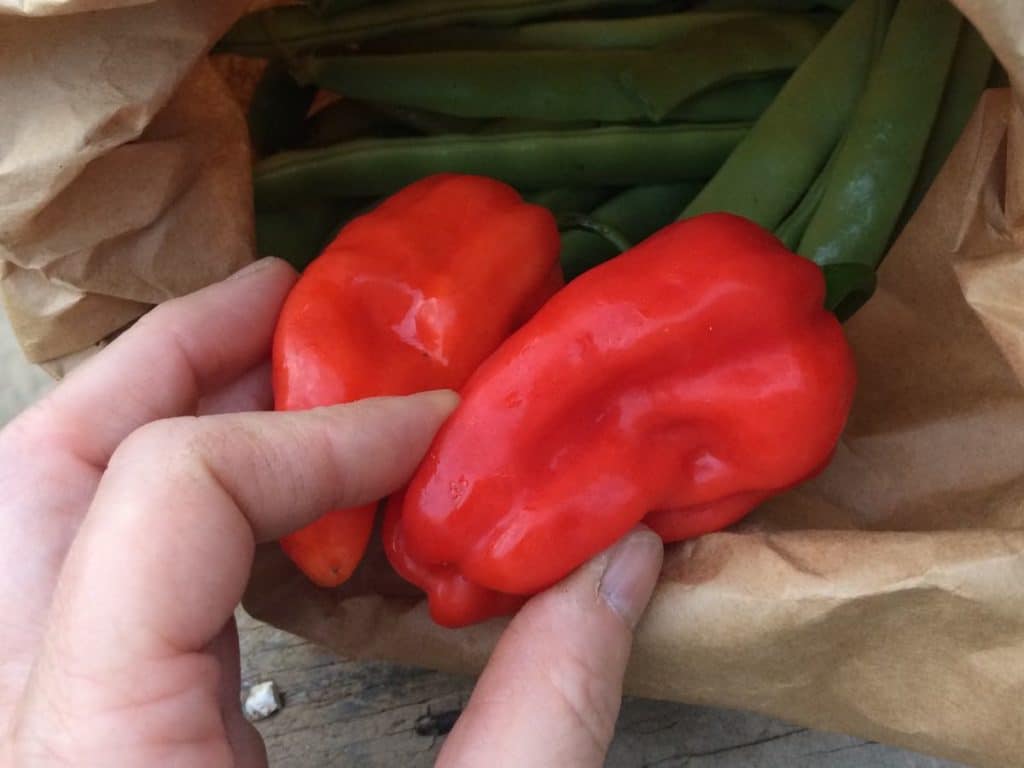
‘Roulette’ chiles – these are flavorful and mild.
RECIPES
Visit our 2019 Recipe Log or our 2018 Recipe Log or join our Facebook discussion group.
LOCAL THYME/ Comforting Classics or Cooking 101
Japanese Street-Style Cabbage Fritters
Braised Chickpeas with Butternut Squash and Cabbage
Veggie Packed Dal with Dried Apricot
Pot Roast with Parsnip and Carrot
LOCAL THYME/ Outside the Box Recipes aka Cooking 202
Chipotle Cabbage Pepper Slaw
Chili Roasted Winter Squash and Parsnip Bruschetta
Cumin and Turmeric Roasted Cauliflower
Cheesy Parsnip Soup
LOCAL THYME/ Quick & Easy Meal
Sesame Noodles with Carrots and Cabbage
????????????
RECIPES FROM LAUREN
LAMB RAGU
Inspired by this James Beard recipe
Takes 2 hours.
Makes 6 cups of sauce.
Serves 8-10 over pasta.
6 tablespoons bacon fat (or neutral oil if you don’t have bacon fat lying around)
2 pounds ground lamb (pork or beef are fine substitute if you don’t have access to lamb)
3 carrots, finely chopped
2 parsnips, finely chopped
1 yellow onion, diced
3 roulette chiles, seeded and minced
2 garlic cloves, minced
1/4 cup tomato paste
1 teaspoon dried thyme
1/2 cup red wine
2 cups chicken stock
2 cups tomato sauce (preferably homemade and frozen though store-bought is also fine)
2 teaspoons Kosher salt
1/2 teaspoon caraway seeds
1/4 teaspoon freshly ground black pepper
1/4 teaspoon cumin
1 pound cooked pasta, for serving
- Add bacon fat to a Dutch oven and heat over medium high heat until smoking. Add the lamb and break up until it forms an even layer. Leave the meat to cook for 10 minutes without moving. It will brown significantly on the bottom. Don’t worry, this is where the flavor comes from. Stir and cook for 10 more minutes without moving.
- Add the carrots, parsnips, onions, peppers and garlic to the pot. Stir to combine and then don’t touch for 5 minutes. Again, browning is good. Saute for 5 minutes until vegetables are softened then add the tomato paste and thyme, and cook for 5 minutes more.
- Add the wine and deglaze the pan, scraping up the browned bits at the bottom of the pan. Cook for 2-3 minutes until the liquid is evaporated then add chicken stock, tomato sauce, salt, caraway, pepper, and cumin. Cover the pot, reduce to a simmer and cook for an hour. Uncover and reduce until it has reached your desired consistency (thickened but still a little loose). Taste and add salt if needed.
- Serve over cooked pasta. My favorite is a fresh or Italian brand rigatoni. I like to use a little bit fancier pasta for this dish but you wouldn’t have to.
.
????????????
.
FALL CABBAGE, SQUASH & CAULIFLOWER GRATIN
Adapted from Food & Wine
Takes 90 minutes, much of it inactive
Serves 6-8
1/2 cup hazelnuts
1 butternut squash, peeled and cut into cubes
1 head cauliflower, cut into florets
1/4 cup olive oil, divided, plus more for greasing pan
4 garlic cloves, peel and thinly sliced
1 teaspoon Kosher salt, divided
1/2 teaspoon freshly ground black pepper, divided
1 head cabbage, cored and thinly sliced
2 cups milk
2 tablespoons cornstarch
4 ounces mild white cheddar or Fontina cheese, shredded
1/4 cup water
- Preheat the oven to 375 degrees. Once preheated, toast hazelnuts for 12 minutes, until fragrant. Coarsely chop and set aside.
- On two baking sheets, combine butternut and cauliflower with 2 tablespoons olive oil. Toss to coat and then sprinkle with garlic, 1/2 teaspoon Kosher salt, and 1/4 teaspoon freshly ground black pepper. Roast for 30 minutes until softened.
- In a large saute pan, heat the remaining two tablespoons olive oil. Add cabbage and season with remaining salt and pepper. Cook over medium heat, stirring occasionally, until wilted.
- Grease a 9 x 13-inch baking dish with olive oil and transfer the cabbage to this dish. Top with roasted squash and cauliflower.
- In a medium sauce pan, heat milk until it just comes to a boil then reduce to low. In a measuring cup, whisk together cornstarch and water until it forms a sort of slurry. Whisk until warm milk until thickened, about 1 minute. Add cheese and season with a little extra salt and pepper. Pour cheese mixture into baking dish and bake for 30 minutes, until bubbling.
- Turn the broiler to high. Transfer dish to the top rack of the oven and broil about 2 minutes, until exposed veggies are browned in spots. Sprinkle with the chopped hazelnuts and serve warm.
.
Week #21, Gleaning party, vicariously
- On: October 09, 2019
 0
0
We are thrilled with how many of you came to the gleaning u-pick this year!
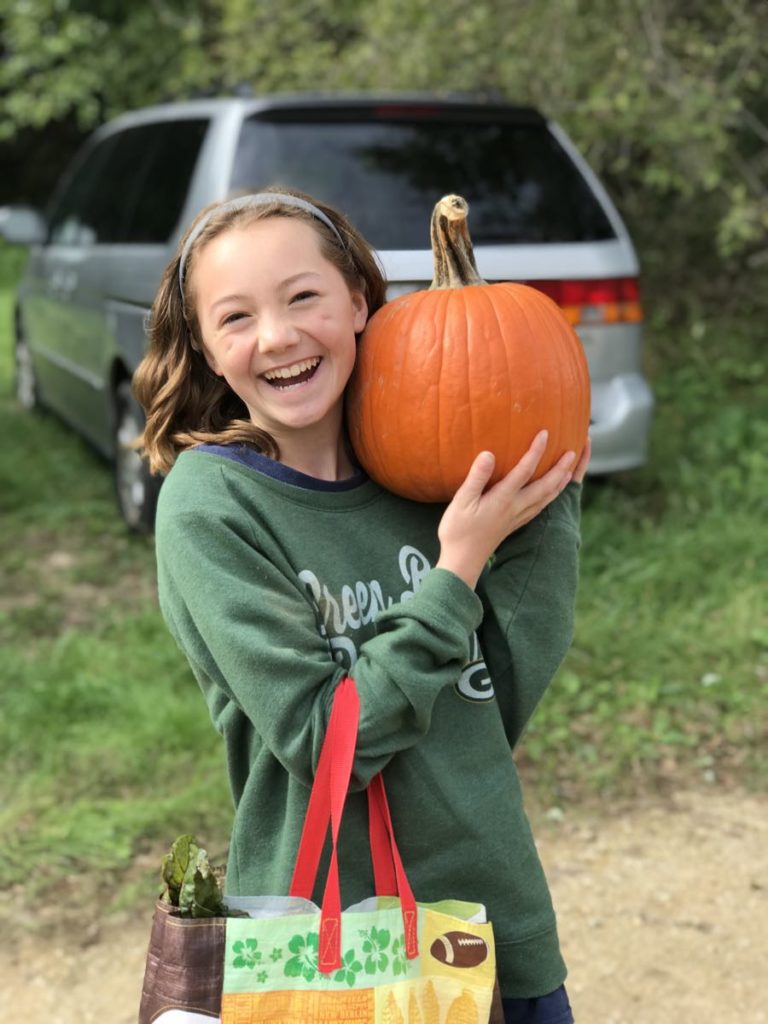
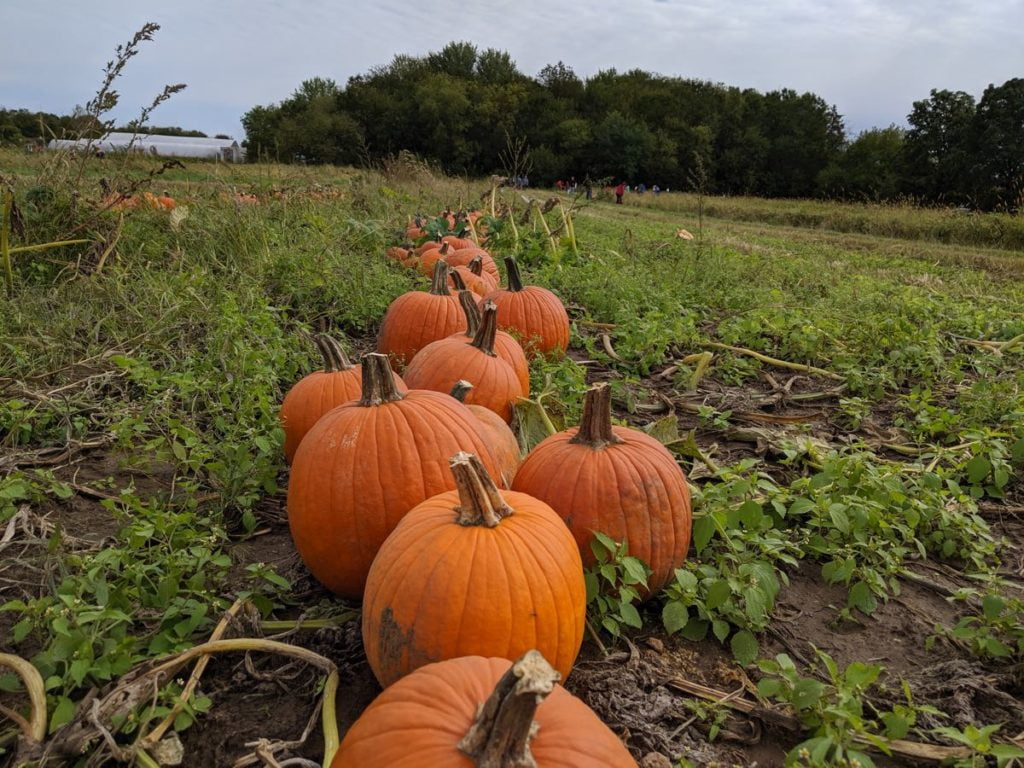
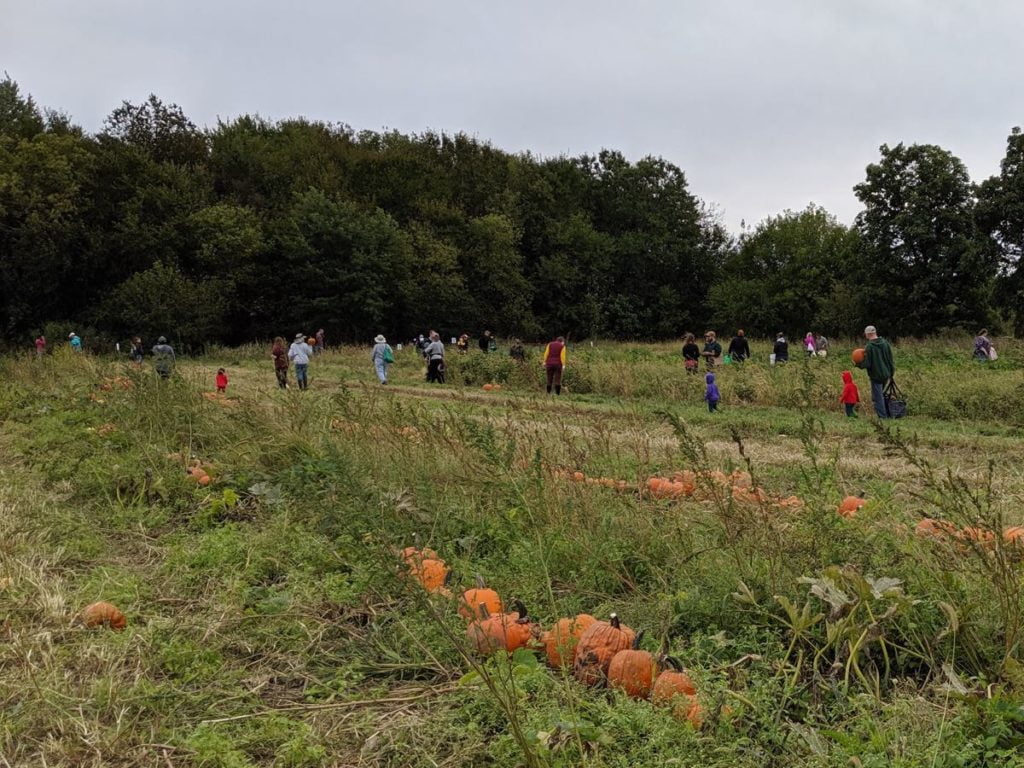
This is an unusually nice pumpkin crop. It was not difficult to find a favorite to take home. The pumpkins are thick-walled! Sharpen your knives when it’s time to carve your jack-o-lantern.


Did you quote my email to your children, “Be cautious about wading into the largest puddles – some are very deep.”? They took it as a challenge. I think every child waded into every puddle and overflowed their boots.
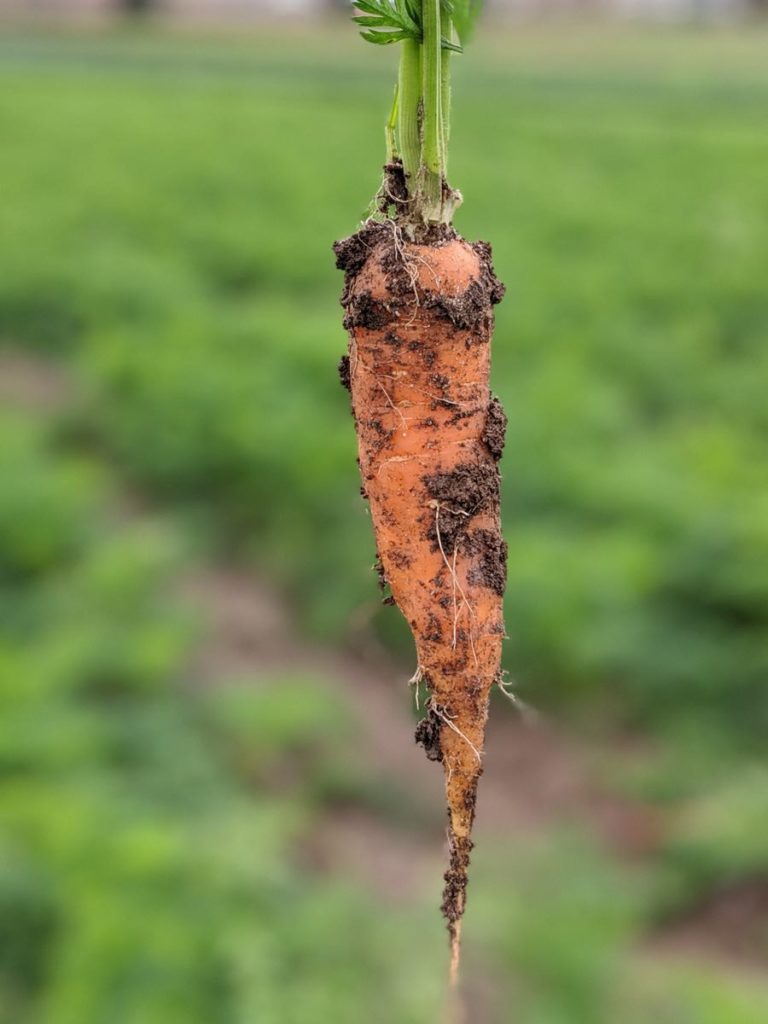
As usual the carrots were a highlight. The kids (and grownups) loved pulling them out of the ground. So exciting.
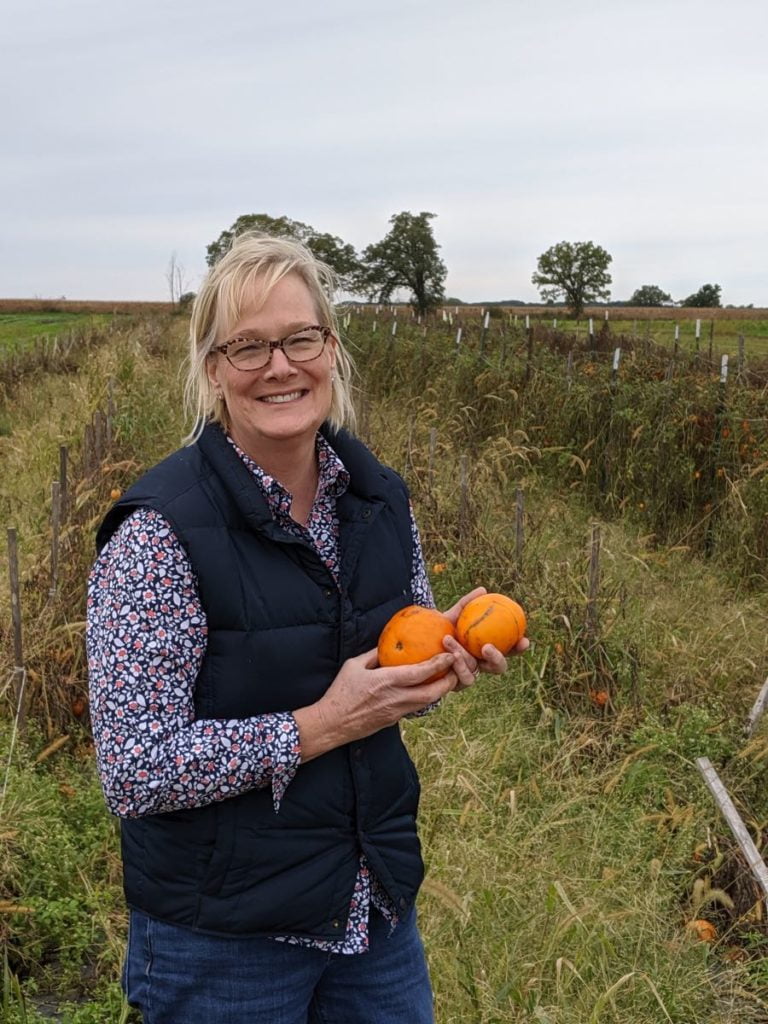
On the other hand, the tomatoes were so sparse and the field was pretty gross by the time the u-pick came around. Too much rain. Kathy was a brave gleaner!
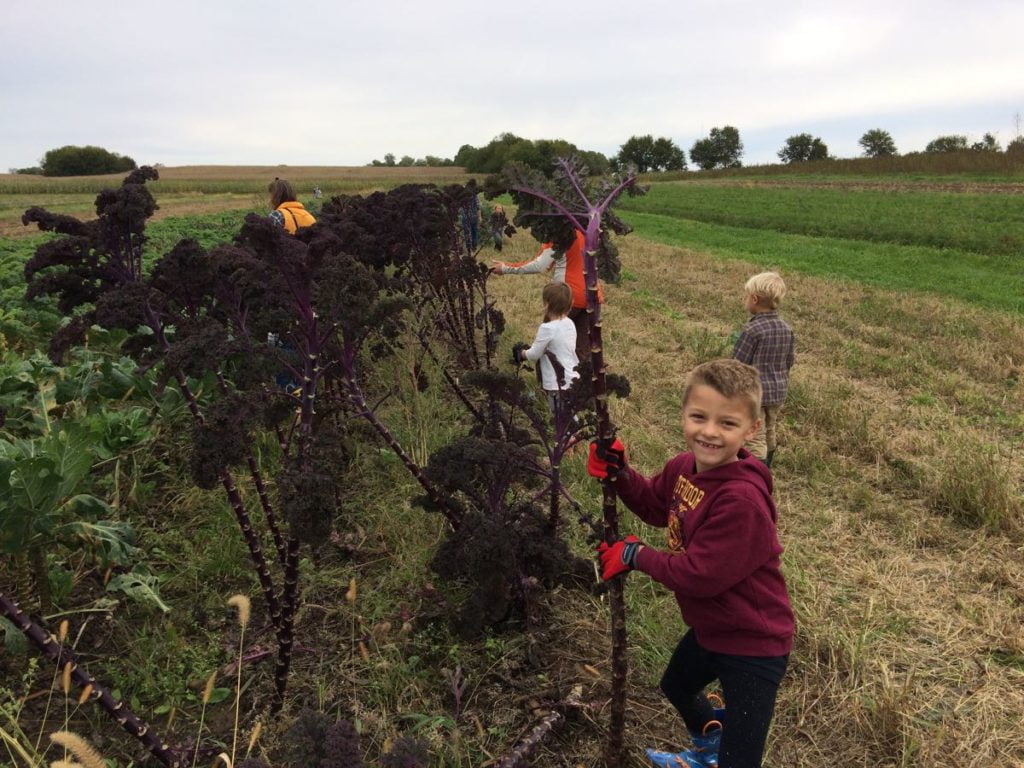
This photo should help you understand gleaning. As kale grows taller, we harvest the bottommost leaves. Look how much we harvested from this plant over the summer. You were finishing the job for us.


Screen-printing t-shirts was a hit, as usual. Many of you wore previous years’ t-shirts to the farm!
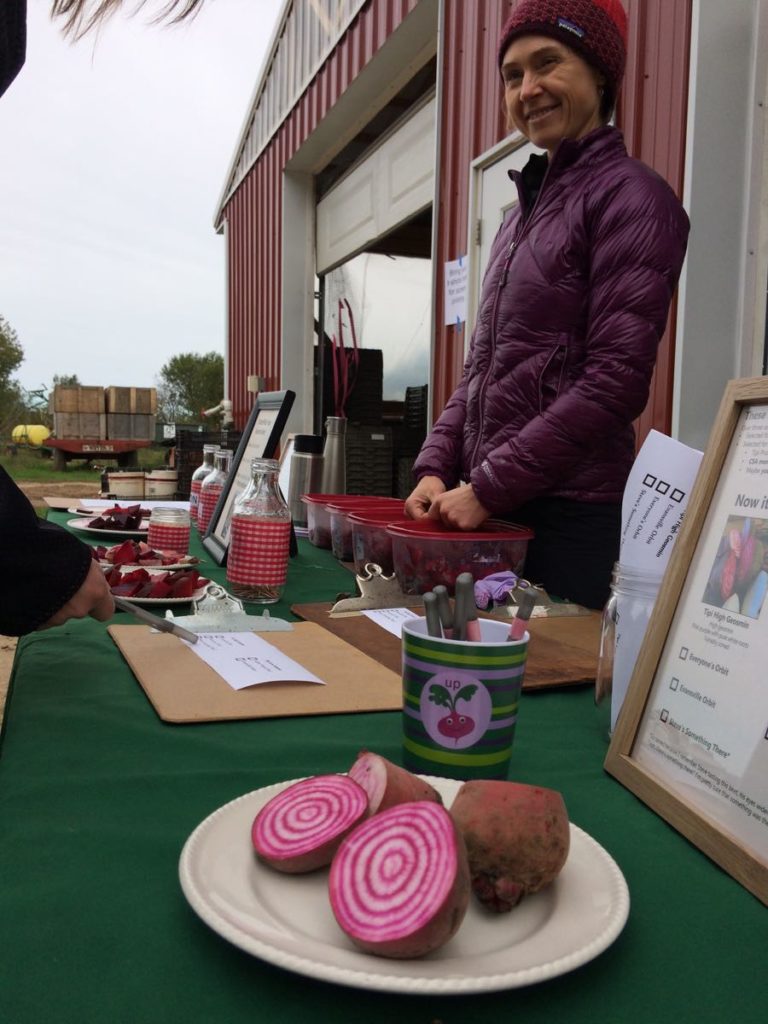
Grad student Solveig Hanson brought cooked beets for tasting and evaluation. This is really special. This is the fourth time she’s conducted a tasting survey at our gleaning party. By now, she is asking us to compare beet lines that she selected with your input over the last three years. That is so cool.

Karen and Monika did a great job clipping and lining up the pumpkins before everyone arrived. We take the time to sort out the icky pumpkins, to give everyone a better chance of taking home nice ones. Photo credits to Ari, me, and various families. Beth
Veggie List and Veggie Notes
Week #21, October 10/11, 2019
– Weekly shares
– EOW/ purple
– Sampler/ moon
Sweet potatoes, ~3 lb
Green beans, 0.85 lb
Fennel with fronds, 1 or 2 bulbs
‘Carnival’ or ‘Jester’ acorn squash, 1
Carrots, 2 lb
Red/green frying or bell peppers, ~3
Orano snack pepper, 1 (orange)
Poblano chiles, 3 (green)
Yellow onion
Garlic
Some sites get 2 cauliflower.
Some sites get cauliflower + broccoli.
Some sites get cauliflower + extra acorn squash.
Next week’s box will probably contain cabbage, carrots, winter squash, and more.
‘Beauregard’ sweet potatoes – Here are a few things we’ve learned about sweet potatoes:
– For best flavor, cook your sweet potatoes so they brown and caramelize. We have a simple, favorite way to roast sweet potatoes. We used to prepare sweet potato fries in the oven. Now we just quarter the potatoes, rub with olive oil, dust with salt and place cut-side-down on a cookie sheet. Roast in a 450 F oven without turning until soft. The flavors will caramelize (like sweet potato fries) but preparation is simpler and the cooking time less exacting. Slender sweet potato fries go from undercooked to overcooked in the blink of an eye. Larger slices are less exacting, and therefore are easier. Small sweet potatoes can be cut just in half. Jumbos will need to be chopped into pieces. Otherwise, they take a long time to cook.
– Store your sweet potatoes at room temperature. They suffer chilling injury below 50 F.
– The sweet potatoes we grow require slightly longer cooking than ones from the supermarket, perhaps because they contain higher moisture so soon after harvest.
– Sweet potatoes are good at any size. We have cooked everything from tiny to jumbo and consistently find that all sizes taste good.
Fennel (large vegetable with a fat bulb and lacy fronds) – Fennel is a ‘swing vegetable’; it can be used raw or cooked. Clean well and slice as thinly as possible for use in raw salads. It is good simply prepared with olive oil, lime or lemon juice, salt and shaved parmesan cheese. Cooking softens and sweetens fennel, and mellows its anise flavor. Both the bulb and leaves are edible. Here are ideas from Alice Water of Chez Panisse about how to use fennel: ‘It’s strong anise characteristic seems to suit fish particularly well. … We use fennel all the time. We add the feathery leaves to marinades for fish and to numerous salads, sauces and soups and we use them as a garnish, too. … The bulbs are sliced and served raw in salads in various combinations with other vegetables, parboiled for pastas; caramelized and served as a side dish; braised whole; or cooked in vegetable broths & fish stocks.”
Poblano chiles (triangular, shiny; green or brown; MEDIUM HEAT) – Poblanos are the creme de la creme of chiles. They have lots of great flavor in combination with manageable heat. Roast and add to soup or casseroles. To reduce heat, remove the seeds and midveins.
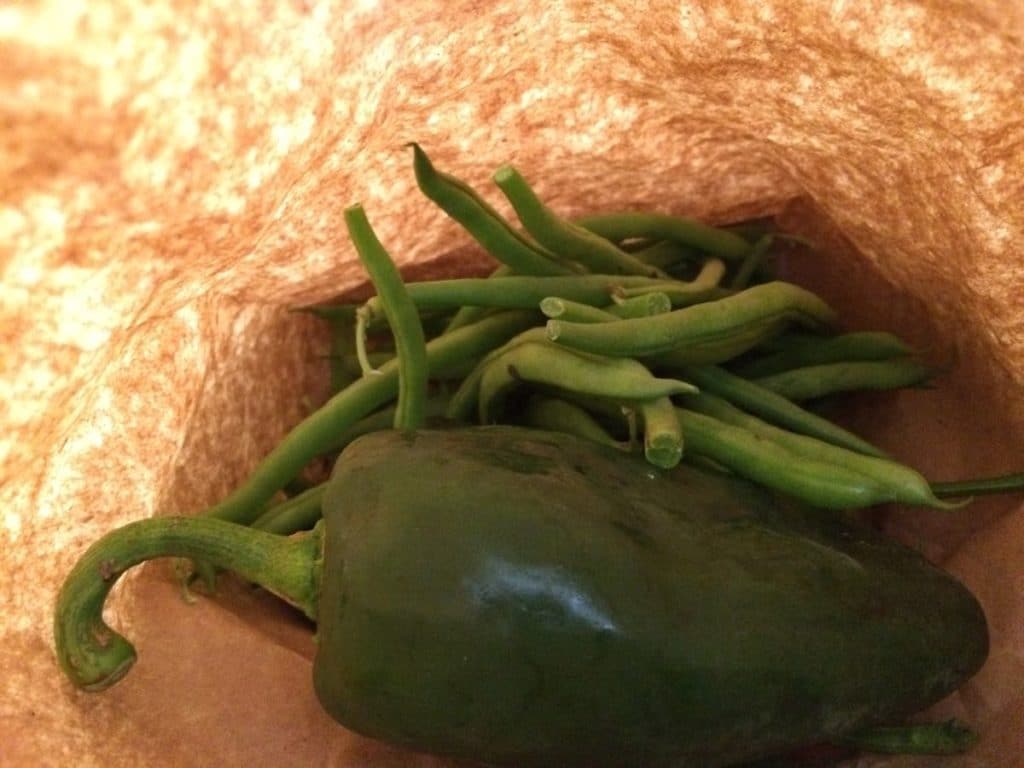
We packed your poblano chiles in the bag of green beans, for easy identification.
RECIPES
Visit our 2019 Recipe Log or our 2018 Recipe Log or join our Facebook discussion group.
LOCAL THYME/ Comforting Classics or Cooking 101
Carrot Winter Squash Puree with Sage Butter
Simmered Veggies in Green Curry Sauce
Teriyaki Noodle Stir Fry with Peppers, Green Beans and Garlic
Chili Stuffed Poblano and Sweet Pepper
Chicken Fennel and Onion Roast
LOCAL THYME/ Outside the Box or Cooking 202
Apple Cranberry Stuffed Acorn Squash Rings
Buffalo Chicken Stuffed Baked Sweet Potato
Green Beans with Olives and Mint
Roasted Poblano Buttermilk Dressing
Sausage and Fennel Hoagies
LOCAL THYME/ Quick & Easy Meal
Sweet Potato Poblano Posole with Pork
????????????
RECIPES FROM LAUREN
BBQ PULLED PORK & SWEET POTATO PIZZA
You definitely got the goods this week to make a double (if not TRIPLE) batch of this favorite pizza. I suggest you throw a party and scale this recipe up big time!
Takes 1 hour (not including time to make pulled pork), add an additional hour if you plan to make the dough from scratch
Makes 14-inch pizza that serves 4-6
1 batch pizza dough (your favorite or use my recipe below!)
2 cups peeled and cubed sweet potato
1 tablespoon olive oil
1/2 teaspoon Kosher salt
1/4 teaspoon freshly ground black pepper
3/4 cup favorite BBQ sauce (I always use Sweet Baby Ray’s Original)
1 cup pulled pork (here’s one of my favorite super easy slow-cooker pulled pork recipes!)
1 red bell pepper (or red Italian fryer), seeded and diced
1 poblano pepper, seeded and diced
1/2 yellow onion, diced
2 cups smoked cheddar cheese, shredded
For the pizza dough:
1-1/2 cups warm water
2 teaspoons active yeast
2 tablespoons honey
4 cups flour
2 teaspoons Kosher salt
- If you are making the dough from scratch, begin here. If not, skip to step 2. Combine warm water (but not hot!) with yeast and honey in a small bowl or measuring cup. Whisk to combine and let sit for 5 minutes. Combine flour and salt together in a large bowl. Make a well in the center of the flour mixture and pour in water with yeast. Stir to combine but do not work the dough at all, just stir until all the ingredients are incorporated together. Let dough rest for 15 minutes. Turn out onto a well-floured counter and knead for 3-5 minutes until smooth and uniform dough forms. Grease or oil a large clean bowl. Add dough, cover with plastic wrap or a towel and let rest in a warm place for an hour or until dough has doubled in size.
- Preheat oven to 425 degrees.
- Combine sweet potatoes, olive oil, salt and pepper in a small bowl to evenly coat. Add to a large baking sheet and bake for 30 minutes. Once finished remove from oven and add back to small bowl. Set aside.
- Preheat oven to 525 degrees.
- Once dough is risen. Roll it out on a well-floured counter until it’s about the size of the baking sheet you used for roasting the squash. Transfer the dough to the baking sheet.
- Top dough with BBQ sauce leaving an inch border on all the edges. Add pork followed by butternut squash, peppers, onions and smoked cheddar.
- Bake for 20 minutes until the crust is golden brown and the cheese is bubbly.
.
????????????
.
CRUNCHY GREEN BEAN BROCCOLI SALAD
Serves 2 (as a meal) or 4 (as a side)
Takes 1 hour
1 head broccoli, cut into florets
15-ounce can chickpeas, drained and rinsed
3 garlic cloves, minced
2 tablespoons olive oil, plus more for drizzling
1/2 teaspoon Kosher salt, plus more to taste
1/4 teaspoon freshly ground black pepper, plus more to taste
1/4 teaspoon dried rosemary
3/4 pound green beans
1 fennel bulb, cored and very thinly sliced
1/4 cup finely chopped fennel fronds
1/4 cup finely chopped parsley, optional
1 tablespoon rice wine vinegar
1/2 tablespoon maple syrup
2 tablespoons sesame seeds (white, black or a combo)
- Preheat oven to 450 degrees.
- On a baking sheet, combine broccoli and chickpeas with garlic, olive oil, salt, pepper and rosemary. Toss with your hands to evenly coat. Roast for 20 minutes, use a spatula to scrape pan and move everything around a bit. Roast 15-20 minutes more until chickpeas are crispy and broccoli is browned in spots.
- Meanwhile, bring a large pot of salted water to a boil on the stove. Add beans and blanch for 5 minutes. Rinse under cold water until cool to the touch. Cut into bite-size pieces and toss with fennel and parsley in a large bowl. Sprinkle with a few pinches of salt and pepper.
- Allow broccoli and chickpeas to cool for 10 minutes then add to bowl. Drizzle with olive oil, vinegar and syrup. Sprinkle with a bit more pinches salt and pepper then the sesame seeds. Stir it all together, taste and adjust seasonings as desired.
.
Week #20; Our first Food Safety review
- On: October 02, 2019
 2
2
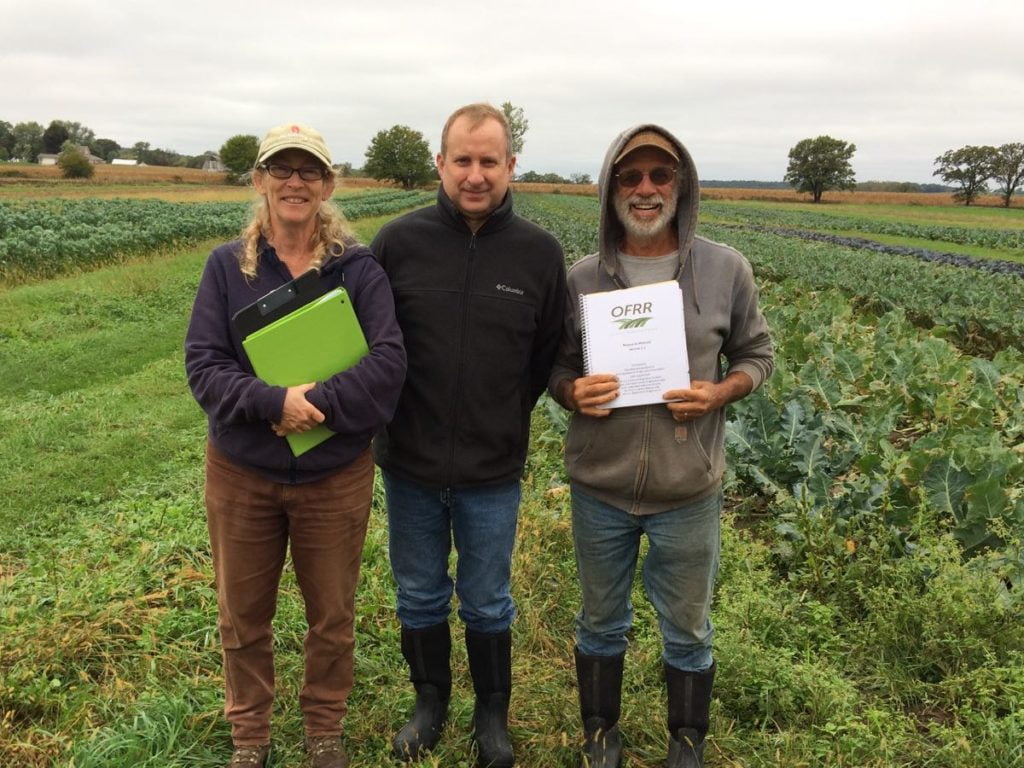
From left; Beth; Michael Barta, Dept of Agriculture, Trade and Consumer Protection (DATCP); Steve. Not in photo, Claire Strader of UW Extension.
We had our first, unofficial farm inspection under the Food Safety Modernization Act (FSMA). “Unofficial” because DATCP offers elective visits with an inspector, a chance to examine our farm without the pressure of an official inspection. The inspector promises to take neither notes nor photographs. It’s strictly informational. Our visit was with DATCP inspector Michael Barta, as well as Claire Strader of UW Extension, who attends these meetings to offer resource support.
FSMA is a big deal for vegetable growers. It’s a federal law intended to prevent outbreaks of food borne illness like E. coli and salmonella on lettuce, melons, etc. The final law was years in the making. Steve and I took FSMA training sessions this past winter and came home with intimidating 2-inch binders of detailed information.
We made two important decisions related to food safety when buying our farm in 2001. First, we knew we wanted a farm with a good underground water supply, and therefore invested in a deep irrigation well. Using surface water (lake, river) for irrigation can contaminate your produce. Second, we chose to avoid all raw manure because of the human pathogens it often carries. Therefore, no livestock, no using the neighbor’s manure, only using soil fertility amendments that we know are free of human pathogens.
The visit went very well. Claire and Michael’s first comment on entering our pack shed was “This is so clean and well organized.” What a great start! It was the middle of a busy work day and I silently thought “Actually, this is pretty messy.” We worked through Michael’s list of topics, eliminating surface water and raw manure as issues right away. They looked at our coolers, pack shed, produce containers, toilets, and fields. We talked a lot about hand-washing and hidden sources of germs. They identified a few things that need attention. We have to do a better job documenting food-safety trainings that we hold for employees. Apparently, we need a back-siphon preventer on our well. There are record-keeping details that need attention.
Over the past month, I prepared as if this were the official inspection, writing up protocols, holding training sessions with the crew, re-thinking some aspects of our pack shed. When in doubt, my motto is always “Stun them with over-preparation.” Honestly, I don’t know how else to function.
Now Steve and I are going to kick back and have a cold beer to celebrate. Beth
Veggie List and Veggie Notes
Week #20, Oct. 3/4, 2019
– Weekly shares
– EOW/ green
Cauliflower
Satina yellow potatoes, 3.5 lb
Leek(s), 1 – 1.25 lb
Green beans, ~3/4 lb
Red frying peppers, 4
Green (or green/red) bell pepper, 1
Orano snack pepper, 1
Broccoli OR Carnival acorn squash (by site)
Yellow onion
Parsley, 1 bunch
Jalapeno (HOT)
Garlic
No tomatoes! They took a nose-dive because of all the rain.
Next week’s box will probably contain sweet potatoes, green cabbage, green beans, yellow onion, poblano chiles and more.
Cauliflower – Storage: Cover and refrigerate. Should store for up to two weeks.
Yellow potatoes – These are good all-purpose potatoes, grown by our friends at Driftless Organics. You will receive one of these varieties: ‘Wega’ (oblong and waxy looking) or ‘Malou’ (round and a little lighter color of yellow).
Green beans – These are some of the best beans of the year. That’s typical as we move into fall weather. Beans grow nicely with cooler nights and less stress. We’ll have more beans for you next week. Storage: Keep in the paper bag but cover the entire paper bag with a plastic bag. It’s a good system. Left in just paper, the beans will wilt in your fridge. With the second layer, they don’t wilt, nor do they rot in contact with the plastic bag.. Alternatively, move them into a closed container of your own.
Leeks (look like big scallions) – We love leeks, one of our favorite fall crops. These alliums have a milder flavor than onions. Nonetheless, they can be used in recipes that call for onions. To wash, split the leek lengthwise, from the green tops about halfway to the base, leaving the base intact. Rinse well under running water, separating the layers to flush. If necessary, split the leek further if soil has penetrated more than halfway down the leek. Shake dry. Leeks are generally eaten cooked. They can be sauteed, steamed or roasted. Intact leeks will store 2 to 3 weeks if covered loosely and refrigerated. The outer leaves will yellow. Just peel them off and discard. The inner leek layers will be fine.
Carnival acorn squash (for a few sites) – Another beautiful speckled acorn squash. Use soon. They are good now but will not store for long.
RECIPES
Visit our 2019 Recipe Log or our 2018 Recipe Log or join our Facebook discussion group.
LOCAL THYME/ Comforting Classics
Lemony Cauliflower Pasta with Bacon
Mashed Potato Puffs
Leek Sweet Pepper Crostini
Roasted Pepper and Tomato Soup
LOCAL THYME/ Outside the Box Recipes
Cauliflower Leek Blue Cheese Soup
Veggie Korma
Grilled Steak with Grilled Peppers and Leeks
Slow Braised Sweet and Hot Pepper Lentils
LOCAL THYME/ Quick & Easy Meal
Chicken and Cauliflower Paprikash
????????????
RECIPES FROM LAUREN
RED PEPPER, POTATO AND HAM FRITTATA WITH RICOTTA
Adapted ever so slightly from the amazing Joshua McFadden Six Seasons cookbook
Takes 45 minutes
Serves 4 easily
1 pound potatoes
Kosher salt and freshly ground black pepper
2 tablespoons butter
3 red frying peppers, seeded and cut into juienne strips
1 leek (white and pale green parts only), cut in half lengthwise and sliced thinly
1/2 yellow onion, diced
4 ounces ham, diced, optional
8 eggs
1/2 cup finely diced fresh parsley
1/2 cup finely grated Parmsan cheese
Extra virgin olive oil
1/2 cup whole-milk ricotta
- Preheat the oven to 400 degrees.
- Put the potatoes in a stock pot and cover with water. Add a couple heavy pinches of salt and bring to a boil over high heat. Cook until the potatoes are tender but not mushy, about 15 minutes. Drain. When cool enough to handle, cut into small bite-size chunks.
- Melt butter in a large heavy, oven-proof skillet (a cast-iron works great if you have one) over medium high heat. Add the peppers, leeks, onion and ham. Season lightly with salt and pepper. Cook until the bell peppers have softened but not browned, about 7 minutes. Add the potatoes to the skillet.
- Crack eggs into a large bowl. Add 1 teaspoon salt, many twists of black pepper, parsley, and the shredded parmesan. Whisk until the eggs are nicely blended. Pour the eggs over the veggies.
- Reduce pan heat to medium and let the eggs sit for 2-3 minutes then carefully slip the spatula around the edges of the eggs, releasing them from the pan (allowing more liquid to flow underneath). Let the new layer of egg cook a bit and then repeat the process a couple more times, about 4 minutes. The top will still be runny but much of it will be set.
- In a small bowl, whisk ricotta lightly with salt and pepper so it’s more of a fluffy consistency. Dollop heaping spoonfuls of ricotta over the eggs in six or seven spots. Transfer to the oven to finish cooking, about 5 minutes. Let the frittata rest and then serve warm in wedges.
.
????????????
.
CHARRED GREEN BEANS WITH TAHINI YOGURT SAUCE
Adapted from the Dining In Cookbook
Takes 20 minutes
Serves 2 for a meal or 4 as a side
1 pound green beans
1/2 cup roughly chopped almonds
1 jalapeno, minced
2 garlic cloves, minced
3 tablespoons apple cider vinegar, divided
Pinch sugar
Kosher salt, divided
1/2 cup Greek yogurt
2 tablespoons tahini
2 tablespoons water
1 tablespoon vegetable oil
1/2 teaspoon freshly ground black pepper
- Bring a large pot of salted water to a boil on the stove. Once boiling, cook your green beans for 5 minutes then drain and rinse under cold water.
- While you wait for the water to boil, you can do a few other things. First toast almonds (either in the oven or on the stove). Then in a small bowl, combine 2 tablespoons vinegar with jalapeno, garlic, a pinch of sugar and a pinch of salt.
- In another small bowl, combine yogurt, tahini, water, remaining vinegar and 1/2 teaspoon Kosher salt. Whisk until smooth.
- Once your beans have been blanched and cooled, heat oil in a large skillet over medium high heat until it glistens. Toss the blanched green beans in there and sprinkle with 1/2 teaspoon Kosher salt and 1/4 teaspoon freshly ground black pepper. Cook over medium high heat, stirring every minute or two until most sides of the green beans are a little charred (about 10 minutes).
- Serve by spreading yogurt mixture over a shallow bowl and topping with green beans. Sprinkle with quick pickled jalapenos and almonds before enjoying. Season with flaky sea salt (or more Kosher salt) and more freshly ground pepper before serving.
.


